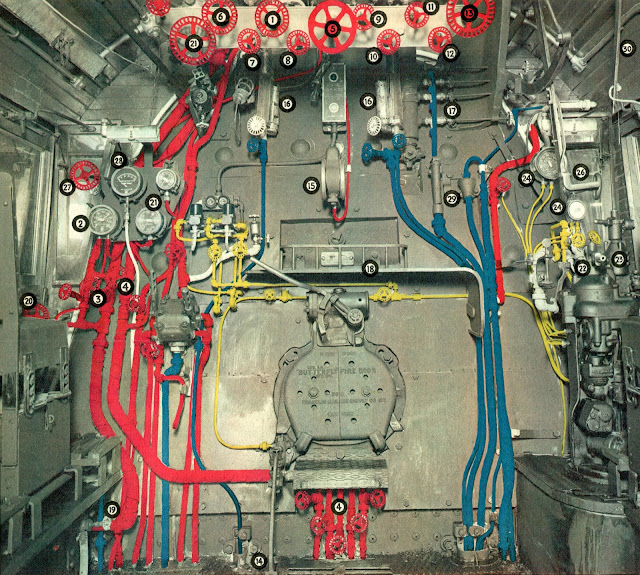 |
| A MILLION DOLLARS A MONTH-THE TWENTIETH CENTURY LIMITED IN 1926 Painting by Walter L. Greene |
Scanned from a 1937 issue of Fortune magazine devoted to the city of New York. This article followed a story on the New York Central Railroad. "The nation's second-largest railroad is favored by geography, goes the right places, admirable plant—but doesn’t pay dividends. The reasons are of national import."
 |
| (For your special edification steam pipes are colored red; air, yellow; waste and water, blue.) |
YOU don a pair of overalls four sizes too big, tie a red bandanna the size of a bed sheet around your neck, tuck an ounce or so of weedy Yankee Girl Scrap into your cheek.
You are handling a train of 7,000 tons with Baldwin’s 62,153rd locomotive, Santa Fe No. 5001, first of ten great 2-10-4 fast freight engines built in 1938.
 |
| Coal-burning engines were hand fired by the fireman, who would shovel several tons of coal into the firebox. The amount of coal shoveled depended on whether the train was traveling over level, hilly, or mountainous terrain. It was the crew’s responsibility to stop and service the engine with coal and water whenever needed. Shown here is Santa Fe No. 5001, a Baldwin 2-10-4 engine, built in 1938. Belen By Baldwin G. Burr |
You climb into the cab and gruffly say to your fireman (sometimes known as tallowpot or ashcat),
“How in hell they going tonight?”
He believes they’re going fine, and tentatively operates the mechanical stoker by opening the stoker valve (1) as testified by the gauge (2), and turning on the stoker engine valve (3) and jet valves (4). No. 5 is the main turret stop valve; it and valves 6 to 13 control steam flowing from the stop valve to the auxiliaries, such as the dynamo, which feeds the headlight. All have been opened by the hostler when he ran the engine out of the roundhouse.
The fireman steps on lever 14, which opens the fire door, and peers into the flames. You squint at the main steam gauge (15), which registers 300 pounds, only ten under a full head; glance at the water glasses (16), double-check the reading by opening the gauge cocks (17). Then you raise hell because your oil-can isn’t on the oil shelf (18), send up to the house for another. Meantime your fireman opens the sprinkler valve (19) and washes down the deck with the attached hose. The engine is very hot, ready to pop, so he shuts down the blower valve (20), reducing draft just enough to draw the smoke out the stack. Since you are pulling freight, he pays no attention to the train-line steam-heat gauge (21). You descend to “oil around,” climb to the cab again, consult your twenty-one-jewel Bunn Special, -
 |
| Bunn Special |
- look back for a brakeman’s signal - it comes; you test the air by manipulating the automatic air-brake valve handle (22). The straight air (2%) is used to brake the engine alone. You watch the air gauge (24).
Now it is time to go. You get the highball signal from the caboose. You release the air (22), throw the reverse lever (25) to full forward position, haul back the throttle lever (26). The great machine trembles, and you push in the throttle so as not to spin the drivers. She moves, lets out a tremendous roar, and you ease out the throttle again. The roar sounds wet around the edges; there's water in the cylinders. You open the cylinder cocks (lever in front of your seat) for a minute, and the steam exhausts directly instead of through the stack.
The roar becomes a blast, and the blasts come quicker. The slack is out, the old girl is rolling. You adjust the reverse lever toward center to increase the valve cutoff. The fireman is opening the feed-water heater (to put water in the boiler) with valve 27, noting the gauge thereto (28): but occasionally you have to use the injector on your side, and rely on the telltale (29) to inform you she is working. You are drumming along at seventy, the exhaust a rhythmically vibrating bellow. You approach a grade crossing. You pull down your whistle lever (30)—two longs and one short followed by a blast held till you reach the crossing. Your left hand is on the brake lever; you are practically on your feet. Tobacco juice drips down your chin, sweat is on your brow. You flash over the highway, sink back limp. “Goddam them fool drivers,” you holler.
 |
| (For your special edification steam pipes are colored red; air, yellow; waste and water, blue.) |


This comment has been removed by a blog administrator.
ReplyDeleteThis comment has been removed by a blog administrator.
ReplyDeleteThis comment has been removed by a blog administrator.
ReplyDelete